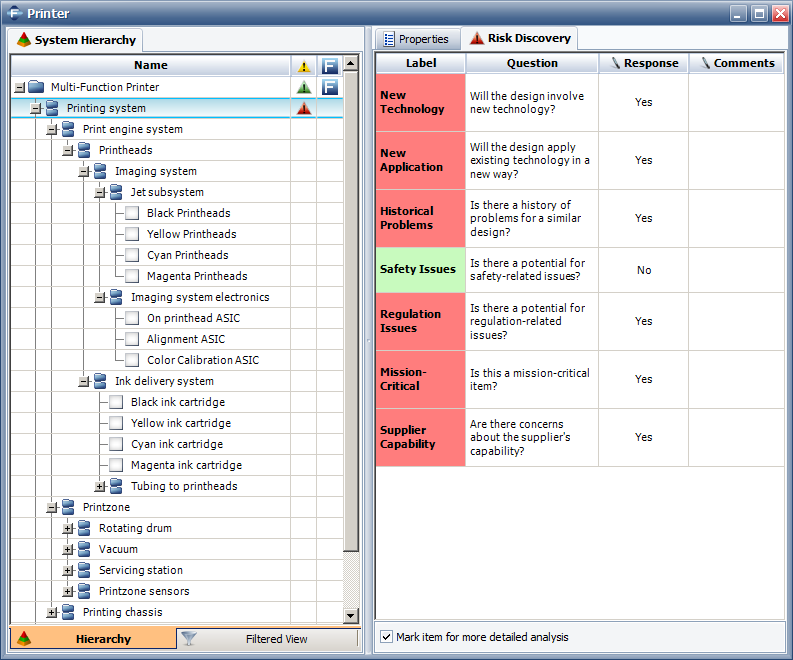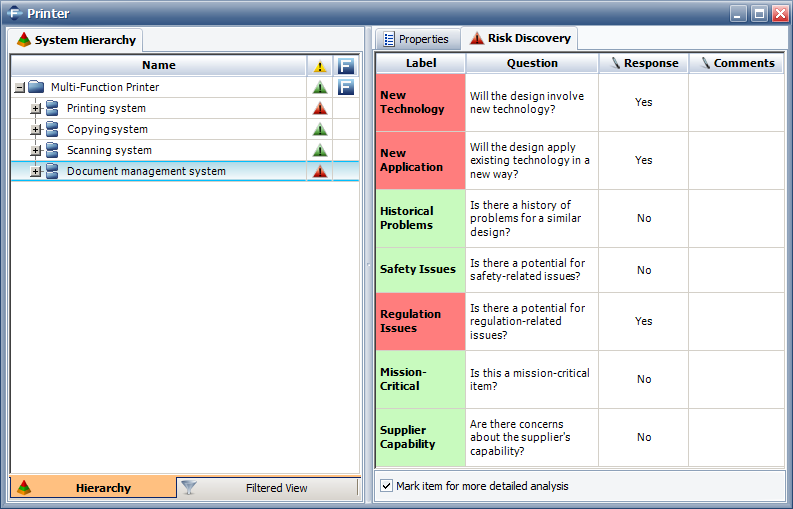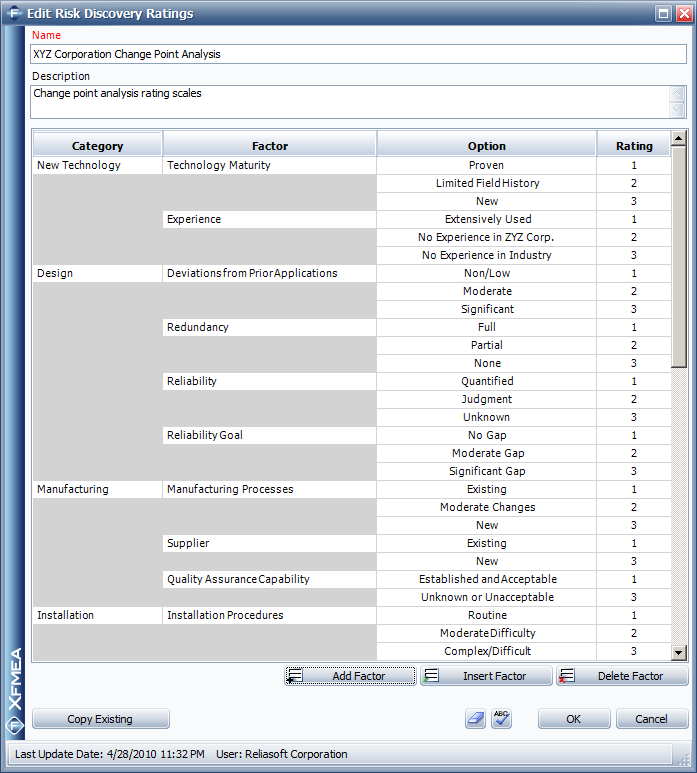Risk Discovery Analysis in Xfmea
[Editor's Note: This article has been updated since its original publication to reflect a more recent version of the software interface.]
One of the most important tasks during a Design for Reliability (DFR) process is to perform Design FMEAs for critical systems, subsystems and components. Although it is ideal to be able to perform FMEAs for all items, few, if any, organizations can afford the time and effort it takes to do everything in a linear fashion.
One of the quality characteristics of successful FMEAs is that the team focuses on high-risk items first. This enables the team to place the highest priority on issues that are really important to address, and leave lower-risk items for later, or even ignore items that the team does not think are worth putting any further effort into investigating. Various methods (such as a preliminary risk assessment or change point analysis) can be used to choose which analyses will be performed and at what level of detail.
How can these concepts be set up into a systematic process? Furthermore, how can ReliaSoft's Xfmea software assist with initial risk discovery so that users can employ a common platform that contains both risk prioritization and the actual FMEA analyses? In this article, we will present the new Risk Discovery analysis functionality in Xfmea and explain how it can help an FMEA team achieve the aforementioned objectives.
Preliminary Risk Assessment or Change Point Analysis
Let’s review the reasons for conducting an FMEA. It is a methodology designed to help an organization:
- Identify and fully understand potential failure modes for a product or process.
- Assess the risk associated with those failure modes and prioritize issues for corrective action.
- Identify and carry out corrective actions to address the most serious concerns.
The assessment of risk is key to streamlining the process. A good FMEA is done as early as possible in a design cycle (in the case of product development) and identifies the high-risk areas quickly. Then the risks are addressed by identifying and executing recommended actions.
Different methods can be used for the initial risk discovery activity. Some organizations might perform a preliminary risk assessment in which the analysts evaluate each assembly or component with respect to a list of relevant factors in order to determine (yes/no) whether it poses sufficient risk to warrant further analysis. In other cases, the organization might use a predefined set of rating scales to assign a score to each factor and then use the overall scores to rank and prioritize the assemblies/components for further analysis.
For example, in a DFR process, the fundamental question that teams are asking when designing a new product is, "What has changed?" or "How much of the new product is new and how much has been modified?" Expert opinion is used to assess:
- How much (if at all) the existing components were modified.
- Whether the proposed application (stress) of the existing components poses new reliability risks.
- Exactly what was changed.
- The current knowledge (or assumptions) concerning the new components in terms of their reliability.
The formal approach to this methodology is called "change point analysis" and a "change point" can be:
- Change in the design.
- Change in the manufacturer.
- Change in the supplier, supplier design or process.
- Change in the usage environment.
- Change in the system — interface points.
- Change in the system — upstream and downstream parts.
- Change in the specification.
- Change in the performance requirements.
- Any other change that can affect reliability.
The fundamental concept behind focusing on what changed is that if a proven design is unchanged, there will be no new reliability/quality problems. The majority of problems lie where changes have occurred. So, if enough attention is paid to the changes and the changes are managed through a systematic process, the design process will be robust and will yield significantly fewer unforeseen problems and surprises.
Utilizing the Risk Discovery Analysis Feature in Xfmea
Let’s examine the new Risk Discovery analysis feature in Xfmea through a fictional example. Suppose that a technology company is developing a new complex product. It is a multi-function printer that prints, copies, scans and has several other features, such as scan to e-mail, document management, etc.
Figure 1 shows the system hierarchy, with some subsystems fully expanded down to the component level and others collapsed at the subsystem level.

Figure 1: Multi-Function Printer System Hierarchy
As a best practice, the team first conducts an FMEA at the top (system) level in order to address any potential problems related to interactions and interfaces. Starting the analysis at lower levels has been proven to be a practice that can lead to omission of interactions between subsystems. In most complex systems, interactions will account for more than 50% of the total failure modes that the system will experience. In such cases, it is essential to start with a top-down approach.
Once the top (system) level FMEA has been completed, the next question that the FMEA team faces is which subsystems and components to focus on. This is where the Risk Discovery feature in Xfmea is used.
The team adds a Risk Discovery analysis for each of the main subsystems of the product: the printing system, the copying system, the scanning system and the document management system. Xfmea supports two configurable methods for this type of analysis: a set of yes/no questions (where a yes answer indicates that the assembly/component poses a risk that warrants more detailed analysis) or a set of predefined rating scales (which can be used to calculate an overall rating for each assembly/component). For this example, we will assume that the organization has selected to use the Questions tab with the sample questions that are shipped by default with the software. These questions address the issues that would typically be considered with a change point analysis approach (new technology, new application, historical problems, supplier capability), together with other relevant issues (safety, regulatory requirements and mission criticality).
When the team uses the questions to discuss each subsystem, they determine that the highest risk assemblies are the printing system followed by the document management system. The copying and scanning systems are highly leveraged from previous designs and as a result they were graded lower in terms of risk. The two assemblies that will receive subsystem level FMEA are marked by selecting the "Mark item for more detailed analysis" check box and they are then highlighted in the system configuration display. Now the team has a clear path of where to focus their FMEA efforts first. Figure 2 shows the analysis for the printing system and Figure 3 shows the system configuration with two subsystems highlighted for more detailed analysis.

Figure 2: Risk Discovery Questions for the Printing System

Figure 3: System Hierarchy with Two Subsystems Highlighted for More Detailed Analysis
Although it will not be discussed in this article, it should be noted that the team has the option to do more Risk Discovery analyses, even at the component level inside the printing system, in order to prioritize component level FMEAs.
Customization of the Risk Discovery Questions and Ratings
As mentioned before, the risk discovery questions and ratings in Xfmea are fully customizable in order to serve specific organizational needs. This allows the tool to serve a wide variety of industries. As an example, Figure 4 shows a partial view of the customized risk discovery rating scales that were developed by an organization that builds and manages oil refineries.

Figure 4: Customized Risk Discovery Rating Scales for a Company that Builds Oil Refineries
Conclusion
Methodologies such as preliminary risk assessment and change point analysis can provide a powerful tool to quickly direct an FMEA team's efforts toward the high-risk areas in a design or process. The new Risk Discovery analysis feature in Xfmea can be configured to fit a variety of different methods and allows the organization to integrate the initial risk discovery analysis results with the FMEAs that are performed on the items with the highest priority.